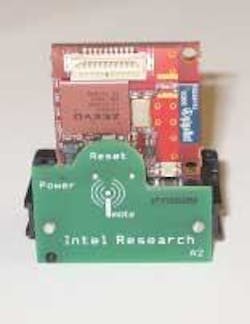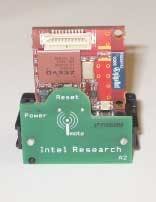Wireless sensors highlighted at Intel Developer Forum
At the recent Intel Developer Forum (Sept. 2004; San Francisco, CA, USA), Patrick Gelsinger, senior vice president and chief technology officer of Intel (Santa Clara, CA, USA; www.intel.com), introduced a new class of wireless network sensors for monitoring and control applications. Dubbed “motes” after the Smart Dust project, an effort funded by the DARPA Network Embedded Software Technology (NEST) program (dtsn.darpa.mil/ixo/programdetail.asp?progid=65) to shrink devices to the size of small particles, the sensors measure environmental factors and relay data from mote to neighboring mote until the information reaches its desired destination.
Developed by Intel in collaboration with the University of California, Berkeley (www.coe.berkeley.edu), these sensors have already found a number of applications, including measuring vibration signatures on semiconductor-manufacturing equipment, camera-stabilization systems, and remote monitoring of railcars (see box below). Several different types of motes are now available from Intel, Crossbow Technology (San Jose, CA, USA; www.xbow.com), and Dust Networks (Berkeley, CA, USA; www. dust-inc.com).
Intel’s Mote is a modular, stackable design that includes a processing module from Zeevo (Santa Clara, CA, USA; www.zeevo.com) that contains an ARM1 core, SRAM, flash memory, Bluetooth wireless technology, an optional power supply regulator, and sensor (see photo on p. 10). According to Ralph Kling, project leader of the mote program, Intel’s ultimate goal is to develop a mote in the form of a single device with sensor, microelectromechanical (MEM) capability, A/D converter, nonvolatile storage, and a battery.
For its part, Crossbow offers mote-development kits designed for developers who need to prototype and build a wireless network running TinyOS. The company’s basic kit includes three MICA2 mote processor/radio boards, a base station, and two sensor boards. A professional kit includes eight motes, sensor- and data-acquisition boards, and a base station.
As part of the Smart Dust project, Kris Pister, a professor at UC Berkeley, has formed Dust Networks, a company that will market wireless sensor network products to industrial and commercial markets. One of the company’s first products is the M1010, an OEM module that provides a way to add wireless communication to sensors, actuators, and controllers. Optimized to run the company’s SmartMesh software, the M1010 is packaged as a wireless subsystem that includes antenna connector, serial interface, seven analog inputs, and nine digital inputs/outputs.
Because such networked embedded systems have resource-limited processing nodes that are tightly coupled to sensors and actuators, application-specific operating systems are required. To address this, UC Berkeley researchers developed TinyOS, a freely available open source operating system specifically for embedded networks (www.tinyos. net/). TinyOS enables each mote to discover its neighbors and determine how data should be routed through the sensor network, juggling data streams and directing transmission of data to other nodes. TinyOS is written in NesC, a programming language for motes developed at Intel and UC Berkeley. An extension of C, NesC supports the motes data-collection ability with a component model that simplifies the creation of applications and data collection.
For example, an application might require measurement of average temperature over a period of time. With NesC, the timer and averaging modules are two software components that can be used by an application to control the sensor. Sensor readings can also be aggregated as the data are routed through the network, reducing the amount of information that each mote transmits, thus conserving power.
To ease the development of sensor-based applications, the Institute for Software Integrated Systems at Vanderbilt University (Nashville, TN, USA; www.isis.vanderbilt.edu) has developed a graphical development environment for TinyOS called GRATIS II. This provides an overview of TinyOS components, interfaces, and applications, and a parser that allows existing TinyOS code to be converted to a graphical representation.
Data also can be extracted from these sensor networks using TinyDB (telegraph.cs.berkeley.edu/tinydb/), a database-like query processing system. Unlike existing solutions for data processing in TinyOS, TinyDB does not require developers to write code. Instead, TinyDB provides an SQL-like interface to specify the data to be extracted, along with additional parameters such as data refresh rates.
To harness the power of these distributed nodes across the Internet in a global-scale sensor network, researchers at Intel and Carnegie Mellon University (Pittsburg, PA, USA; www.cmu.edu) have developed a wide-area architecture called IrisNet (intel-iris.net) to allow real-time video and other types of sensor data to be transmitted across networks. Each sensor is locally attached to a computer that is capable of resource-intensive processing such as image recognition. Already, IrisNet is being used by researchers at Oregon State University (Corvallis, OR, USA; oregonstate.edu/) on a network of computer-based camera systems along the Oregon coast to understand the natural processes of coastal areas, and how these affect economy and public safety.
Data collection by mote control
Sensor networks help BP in supply-chain logistics
www.bp.com/liveassets/bp_internet/globalbp/STAGING/global_assets/images/fr/downloads/Frontiers_magazine_issue_09_smart_surrogates.pdf
Using motes for camera stabilization
www.xbow.com/Industry_solutions/Stabilization.htm
Sensor networks are being used to study seabird behavior
www.greatduckisland.net/
Researchers built networked system to track soldiers
www.cse.ohio-state.edu/siefast/nest/nest_webpage/ALineInTheSand.html
Oregon vineyard uses motes for plant monitoring
www.intel.com/labs/features/rs01031.htm
Motes monitor the San Andreas fault
www.ess.ucla.edu/faculty/davis/index.asp
Treetop motes measure forest environments
www.berkeley.edu/news/media/releases/2003/07/28_redwood.shtml

